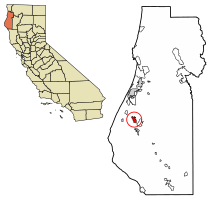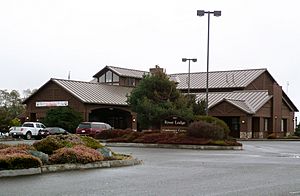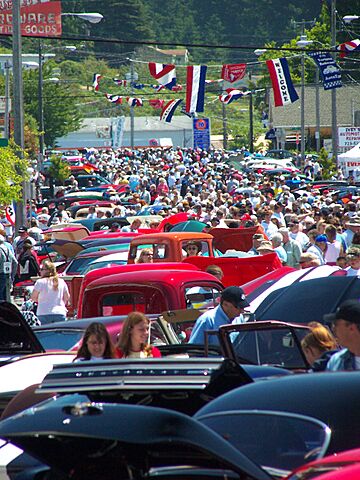Fortuna, California facts for kids
Quick facts for kids
Fortuna, California
|
||
|---|---|---|

Main Street in Fortuna in the 1940s
|
||
|
||
| Nickname(s):
The Friendly City
|
||

Location of Fortuna in Humboldt County, California
|
||
| Country | United States | |
| State | California | |
| County | Humboldt | |
| Incorporated | January 20, 1906 | |
| Government | ||
| • Type | Council/Manager | |
| Area | ||
| • Total | 5.25 sq mi (13.60 km2) | |
| • Land | 5.25 sq mi (13.59 km2) | |
| • Water | 0.00 sq mi (0.00 km2) 0% | |
| Elevation | 66 ft (20 m) | |
| Population | ||
| • Total | 12,516 | |
| • Density | 2,384/sq mi (920.97/km2) | |
| Time zone | UTC-8 (Pacific (PST)) | |
| • Summer (DST) | UTC-7 (PDT) | |
| ZIP code |
95540
|
|
| Area code(s) | 707 | |
| FIPS code | 06-25296 | |
| GNIS feature IDs | 277520, 2410532 | |
Fortuna is a friendly city in California, located right by the Eel River. It's about 9 miles (14 km) from the Pacific Ocean. The city is also on U.S. Route 101, a major highway. In Spanish, "Fortuna" means "Fortune." The local Wiyot people call it Vutsuwitk Da'l. In 2020, about 12,516 people lived here. Fortuna is often called "The Friendly City."
Contents
History of Fortuna

Fortuna has an interesting history with a few name changes! It started as "Slide" in 1874, named after a nearby hill. Then, in 1875, it became "Springville" because of the many natural springs and a new lumber mill. This mill helped the town grow.
However, there was already another "Springville" in California. So, in 1884, the people living here decided to change the name again. They chose "Fortuna," which means "fortune" in Spanish. They felt very lucky to live in such a beautiful place, surrounded by forests, a river, and the ocean. Some say a local real estate agent suggested the name to attract more people.
Electricity came to Fortuna quite early, in 1883. A company that owned the local mill built a power plant. This plant not only powered the mills but also brought electric lights to the townspeople, which was a big deal back then!
Fortuna officially became a city on February 20, 1906. Thanks to the Eel River, it became known for growing vegetables, berries, and fruits. Fishing was also important. But the lumber industry, which started the town, remained its main business for a long time.
A nearby town called Rohnerville used to be a busy spot for gold miners. But when the railroad decided to go through Fortuna instead, Fortuna became the main hub. The Eel River and Eureka Railroad was built in 1884. It helped connect lumber mills and farms to shipping routes. Later, this railroad became part of the Northwestern Pacific Railroad, linking Fortuna all the way to San Francisco by 1914. This made Fortuna a central point for many smaller communities around it.
Since its early days, Fortuna has been known as "The Friendly City."
Geography and Nature
Fortuna covers about 4.8 square miles (12.4 square kilometers) of land. It sits on the bank of the Eel River, about 7 miles (11 km) from the Pacific Ocean. The city's location means it gets coastal weather, but its summers are usually warmer and less foggy than towns closer to the coast.
Fortuna is on U.S. Route 101, which connects it to San Francisco (about 253 miles or 407 km south) and Eureka (about 14 miles or 23 km north). Another important road, California State Route 36, starts just south of Fortuna.
The area around Fortuna is famous for its amazing redwood forests. These giant trees can grow up to 300 feet (91 meters) tall and live for 2,500 years! Fortuna is often called the "gateway" to these incredible forests. You can drive along the 33-mile (53 km) Avenue of the Giants to see many redwood groves and hiking trails.
Climate in Fortuna
Fortuna has a warm-summer Mediterranean climate. This means it has warm, dry summers and mild, rainy winters. It's a typical climate for the North Coast region.
| Climate data for Fortuna, California | |||||||||||||
|---|---|---|---|---|---|---|---|---|---|---|---|---|---|
| Month | Jan | Feb | Mar | Apr | May | Jun | Jul | Aug | Sep | Oct | Nov | Dec | Year |
| Mean daily maximum °F (°C) | 54.4 (12.4) |
55.9 (13.3) |
57.7 (14.3) |
60.1 (15.6) |
63.6 (17.6) |
66.6 (19.2) |
69.3 (20.7) |
70.0 (21.1) |
69.4 (20.8) |
65.0 (18.3) |
58.0 (14.4) |
53.4 (11.9) |
62.0 (16.6) |
| Daily mean °F (°C) | 47.7 (8.7) |
48.7 (9.3) |
50.1 (10.1) |
51.3 (10.7) |
55.8 (13.2) |
58.9 (14.9) |
61.2 (16.2) |
61.9 (16.6) |
60.2 (15.7) |
56.1 (13.4) |
50.7 (10.4) |
46.9 (8.3) |
54.1 (12.3) |
| Mean daily minimum °F (°C) | 41.0 (5.0) |
41.5 (5.3) |
42.5 (5.8) |
44.2 (6.8) |
48.0 (8.9) |
51.1 (10.6) |
53.1 (11.7) |
53.7 (12.1) |
50.9 (10.5) |
47.2 (8.4) |
43.4 (6.3) |
40.4 (4.7) |
46.4 (8.0) |
| Average precipitation inches (mm) | 8.0 (200) |
7.2 (180) |
6.7 (170) |
3.9 (99) |
2.0 (51) |
0.7 (18) |
0.1 (2.5) |
0.3 (7.6) |
0.6 (15) |
2.6 (66) |
6.5 (170) |
10.1 (260) |
48.7 (1,239.1) |
| Average snowfall inches (cm) | 0 (0) |
0.3 (0.76) |
0.1 (0.25) |
0 (0) |
0 (0) |
0 (0) |
0 (0) |
0 (0) |
0 (0) |
0 (0) |
0 (0) |
0 (0) |
0.4 (1.01) |
| Average rainy days | 16.7 | 14.7 | 16.1 | 12.9 | 9.2 | 5.3 | 2.3 | 2.4 | 3.6 | 7.8 | 14.8 | 16.9 | 122.7 |
| Average snowy days | 0.1 | 0.1 | 0.1 | 0 | 0 | 0 | 0 | 0 | 0 | 0 | 0 | 0.1 | 0.4 |
Population and People
| Historical population | |||
|---|---|---|---|
| Census | Pop. | %± | |
| 1910 | 383 | — | |
| 1920 | 986 | 157.4% | |
| 1930 | 1,239 | 25.7% | |
| 1940 | 1,413 | 14.0% | |
| 1950 | 1,762 | 24.7% | |
| 1960 | 3,523 | 99.9% | |
| 1970 | 4,203 | 19.3% | |
| 1980 | 7,591 | 80.6% | |
| 1990 | 8,788 | 15.8% | |
| 2000 | 10,497 | 19.4% | |
| 2010 | 11,926 | 13.6% | |
| 2020 | 12,516 | 4.9% | |
| U.S. Decennial Census | |||
Fortuna has grown quite a bit over the years! In 2020, its population was 12,516 people. Most residents are White, but there are also many people from other backgrounds, including Native American, Asian, and Hispanic or Latino communities. About a quarter of the population is under 18 years old.
Economy and Jobs
Fortuna has several important employers that help the city's economy. These include the City of Fortuna itself, local school districts (Fortuna Union Elementary and High School), and Redwood Memorial Hospital. Other businesses like Eel River Disposal, Safeway, and St. Luke Healthcare and Rehabilitation Center also provide many jobs. The River Lodge is a place where meetings and events are held, bringing visitors and business to the city.
Education in Fortuna
Students in Fortuna attend schools within the Fortuna Elementary School District and the Fortuna Union High School.
Getting Around
You can travel to and from Fortuna using the Amtrak Thruway 7 bus service. This bus connects Fortuna to other cities like Martinez (to the south) and Arcata (to the north). From Martinez, you can connect to other Amtrak train routes.
Fun Things to Do and Culture
Fortuna is a lively city with many events and festivals throughout the year! Some popular ones include:
- The Daffodil Festival
- Art & Wine in the Park
- The Annual Fortuna Rodeo
- The Redwood AutoXpo, which brings thousands of visitors to see cool cars
- Logging Competitions, showing off skills from the timber industry
- Civil War Days, a historical reenactment
- Apple Harvest festival
- Hops in Humboldt festival
- The Fortuna Concert Series, with music performances
- Holiday events like concerts and parades
The Eel River has also been the site of the Paddle to the Headwaters canoe race, a fun event for water sports lovers.
Famous People from Fortuna
Many talented people have connections to Fortuna, including:
- Jean Buckley, a baseball player in the All-American Girls Professional Baseball League.
- John A. Campbell, a leader in the lumber industry.
- Reggie Christiansen, a college baseball coach.
- Jon Crosby, a musician and founder of the band VAST.
- Cecelia Holland, a historical novelist.
- Randy Niemann, a major league baseball player and coach.
- Sam Reynolds, a professional soccer player.
- Ryan Villopoto, a professional supercross and motocross champion.
See also
 In Spanish: Fortuna (California) para niños
In Spanish: Fortuna (California) para niños





